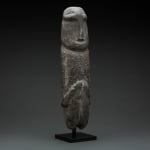Mezcala Stone Idol, 300 BCE - 300 CE
Stone
33 x 8.3 x 6.3 cm
13 x 3 1/4 x 2 1/2 in
13 x 3 1/4 x 2 1/2 in
X.0460
Further images
This sculpture exudes a force of the ages. It has witnessed the passage of seasons and the passage of civilizations. Today it stands as the reminder of a forgotten era....
This sculpture exudes a force of the ages. It has witnessed the passage of seasons and the passage of civilizations. Today it stands as the reminder of a forgotten era. However, superstitions still pervade our modern society and today, our understanding of the universe and science still cannot provide answers to all our questions. Like a miniature idol from Easter Island, the facial features of this figure are clearly defined with a prominent jaw, raised brow, and T-shaped nose. His legs are slightly open and his elongated arms are clenched tightly to the sides of his torso. If inverted, the figure transforms into the head of a jaguar, the sacred beast of the jungles of Mexico, much like shamans were thought to transmogrify into wild animals. The open legs become ears, the carved diagonal lines that indicate the forearms become eyes, and the figure’s face becomes the feline’s muzzle. Meanwhile, the columnar contours of the statue also echo the form of a phallus. Similar idols were believed to have been used as pestles to grind up corn or wheat. Given the large size of this figure, it is possible that it was used as a pestle in a ceremonial context and the top of the head does exhibit wear consistent with such a use. Thus as the women of the tribe prepared the food, they would have held in their hands the symbol of male fertility, linking the immediate survival of the community through food with the procreation of the species through copulation. All at the same time invoking the favors of the gods. The power present in this statue is as real today as it was in ancient times. The vital components of life never change. This image of fertility, of nourishment, of the divine, is as relevant to our reality as it was to those who carved it.





